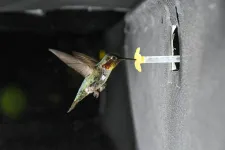(Press-News.org) The hummingbird is named after its pleasant humming sound when it hovers in front of flowers to feed. But only now has it become clear how the wing generates the hummingbird's namesake sound when it is beating rapidly at 40 beats per second. Researchers from Eindhoven University of Technology, Sorama, a TU/e spin-off company, and Stanford University meticulously observed hummingbirds using 12 high-speed cameras, 6 pressure plates and 2176 microphones. They discovered that the soft and complex feathered wings of hummingbirds generate sound in a fashion similar to how the simpler wings of insect do. The new insights could help make devices like fans and drones quieter.
The team of engineers succeeded in measuring the precise origin of the sound generated by the flapping wings of a flying animal for the first time. The hummingbird's hum originates from the pressure difference between the topside and underside of the wings, which changes both in magnitude and orientation as the wings flap back and forth. These pressure differences over the wing are essential, because they furnish the net aerodynamic force that enables the hummingbird bird to liftoff and hover.
Unlike other species of birds, a hummingbird wing generates a strong upward aerodynamic force during both the downward and upward wing stroke, so twice per wingbeat. Whereas both pressure differences due to the lift and drag force acting on the wing contribute, it turns out that the upward lifting pressure difference is the primary source of the hum.
The difference between whining, humming, buzzing and wooshing
Professor David Lentink of Stanford University: "This is the reason why birds and insects make different sounds. Mosquitoes whine, bees buzz, hummingbirds hum, and larger birds 'woosh'. Most birds are relatively quiet because they generate most of the lift only once during the wingbeat at the downstroke. Hummingbirds and insects are noisier because they do so twice per wingbeat."
The researchers combined all measurements in a 3D acoustic model of bird and insect wings. The model not only provides biological insight into how animals generate sound with their flapping wings, it also predicts how the aerodynamic performance of a flapping wing gives the wing sound its volume and timbre. "The distinctive sound of the hummingbird is perceived as pleasant because of the many 'overtones' created by the varying aerodynamic forces on the wing. A hummingbird wing is similar to a beautifully tuned instrument," Lentink explains with a smile.
High-tech sound camera
To arrive at their model, the scientists examined six Anna's hummingbirds, the most common species around Stanford. One by one, they had the birds drink sugar water from a fake flower in a special flight chamber. Around the chamber, not visible to the bird, cameras, microphones and pressure sensors were set up to precisely record each wingbeat while hovering in front of the flower.
You can't just go out and buy the equipment needed for this from an electronics store. CEO and researcher Rick Scholte of Sorama, a spin-off of TU Eindhoven: "To make the sound visible and be able to examine it in detail, we used sophisticated sound cameras developed by my company. The optical cameras are connected to a network of 2176 microphones for this purpose. Together they work a bit like a thermal camera that allows you to show a thermal image. We make the sound visible in a 'heat map', which enables us to see the 3D sound field in detail."
New aerodynamic force sensors
To interpret the 3D sound images, it is essential to know what motion the bird's wing is making at each sound measurement point. For that, Stanford's twelve high-speed cameras came into play, capturing the exact wing movement frame-by-frame.
Lentink: "But that's not end of story. We also needed to measure the aerodynamic forces the hummingbird's wings generates in flight. We had to develop a new instrument for that." During a follow-up experiment six highly sensitive pressure plates finally managed to record the lift and drag forces generated by the wings as they moved up and down, a first.
The terabytes of data then had to be synchronized. The researchers wanted to know exactly which wing position produced which sound and how this related to the pressure differences. Scholte: "Because light travels so much faster than sound, we had to calibrate each frame separately for both the cameras and the microphones, so that the sound recordings and the images would always correspond exactly." Because the cameras, microphones and sensors were all in different locations in the room, the researchers also had to correct for that.
Algorithm as a composite artist
Once the wing location, the corresponding sound and the pressure differences are precisely aligned for each video frame, the researchers were confronted with the complexity of interpretating high volume data. The researchers tackled this challenge harnessing artificial intelligence, the research of TU/e PhD student, and co-first author, Patrick Wijnings.
Wijnings: "We developed an algorithm for this that can interpret a 3D acoustic field from the measurements, and this enabled us to determine the most probable sound field of the hummingbird. The solution to this so-called inverse problem resembles what a police facial composite artist does: using a few clues to make the most reliable drawing of the suspect. In this way, you avoid the possibility that a small distortion in the measurements changes the outcome."
The researchers finally managed to condense all these results in a simple 3D acoustic model, borrowed from the world of airplanes and mathematically adapted to flapping wings. It predicts the sound that flapping wings radiate, not only the hum of the hummingbird, but also the woosh of other birds and bats, the buzzing and whining of insects and even the noise that robots with flapping wings generate.
Making drones quieter
Although it was not the focus of this study, the knowledge gained may also help improve aircraft and drone rotors as well as laptop and vacuum cleaner fans. The new insights and tools can help make engineered devices that generate complex forces like animals do quieter.
This is exactly what Sorama aims to do: "We make sound visible in order to make appliances quieter. Noise pollution is becoming an ever-greater problem. And a decibel meter alone is not going to solve that. You need to know where the sound comes from and how it is produced, in order to be able to eliminate it. That's what our sound cameras are for. This hummingbird wing research gives us a completely new and very accurate model as a starting point, so we can do our work even better," concludes Scholte.
INFORMATION:
This research appears on March 16 in the journal eLife, under the title "How Oscillating Aerodynamic Forces Explain the Timbre of the Hummingbird's Hum and Other Animals in Flapping Flight." The experimental and analytical work of this research was conducted by PhD student Patrick Wijnings of TU Eindhoven under the supervision of Rick Scholte of Sorama and Sander Stuijk and Henk Corporaal of TU/e, and PhD student Ben Hightower of Stanford under the supervision of David Lentink of Stanford University with the assistance of four co-authors from the Lentink Lab: Rivers Ingersoll, Diana Chin, Jade Nguyen and Daniel Shorr. This research was financed by NWO Perspectief program ZERO and CAREER AWARD National Science Foundation (NSF).
Tsukuba, Japan - Fungi are a vital part of nature's recycling system of decay and decomposition. Filamentous fungi spread over and penetrate surfaces by extending fine threads known as hyphae.
Fungi that cause disease within living organisms can penetrate the spaces between tightly connected plant or animal cells, but how their hyphae do this, and why the hyphae of other fungal species do not, has been unclear.
Now, a team led by Professor Norio Takeshita at University of Tsukuba, with collaborators at Nagoya University and in Mexico, has discovered a key feature that helps explain the differences among species. They compared seven fungi from different taxonomic groups, including some ...
Washington, D.C. - March 16, 2021 - For the first time, researchers have isolated the fungus Candida auris from a sandy beach and tidal swamp in a remote coastal wetland ecosystem. The discovery, reported this week in mBio, an open-access journal of the American Society for Microbiology, represents the first evidence that the pathogen thrives in a natural environment and is not limited to mammalian hosts. C. auris can cause infections resistant to major antifungal drugs, and since its identification in clinical patients 10 years ago scientists have sought to understand its origins.
A ...
SLOW walkers are almost four times more likely to die from COVID-19, and have over twice the risk of contracting a severe version of the virus, according to a team of researchers from the National Institute for Health Research (NIHR) Leicester Biomedical Research Centre led by Professor Tom Yates at the University of Leicester.
The study of 412,596 middle-aged UK Biobank participants examined the relative association of body mass index (BMI) and self-reported walking pace with the risk of contracting severe COVID-19 and COVID-19 mortality.
The analysis found slow walkers of a normal weight to be almost 2.5 times more likely to develop severe COVID-19 and 3.75 times more likely to die from the virus ...
Boston, Mass. - Just one year after the World Health Organization declared the novel coronavirus a global pandemic, three COVID-19 vaccines are available in the United States, and more than 2 million Americans are receiving shots each day. Americans are eager to get back to business as usual, but experts caution that opening the economy prematurely could allow a potential resurgence of the virus. How foot traffic patterns in restaurants and bars, schools and universities, nail salons and barbershops affect the risk of transmission has been largely unknown.
In an article published ...
LA JOLLA, CALIF. - March 16, 2021 - A Nature study authored by scientists at Sanford Burnham Prebys Medical Discovery Institute and the University of Hong Kong shows that the leprosy drug clofazimine, which is FDA approved and on the World Health Organization's List of Essential Medicines, exhibits potent antiviral activities against SARS-CoV-2 and prevents the exaggerated inflammatory response associated with severe COVID-19. Based on these findings, a Phase 2 study evaluating clofazimine as an at-home treatment for COVID-19 could begin immediately.
"Clofazimine is an ideal candidate for a COVID-19 treatment. It is safe, affordable, easy to make, taken as a pill and can be made globally available," ...
A study by Queen Mary University of London researchers, funded by Cancer Research UK, confirms the role of the oestrogen receptor biomarker in ductal carcinoma in situ and presents a new and more accurate method to predict long term outcomes for this pre-invasive stage of breast cancer. The study is published in Clinical Cancer Research.
Oestrogen receptor (ER), a protein expressed in some breast cancer cells, is routinely tested in invasive breast cancer to predict long-term outcomes select treatment options. Its role in ductal carcinoma in situ (DCIS) has been previously unclear, and it is not generally evaluated in this pre-invasive stage of breast cancer. The new research confirms the role of ER in predicting ...
A new study in Nicotine & Tobacco Research, published by Oxford University Press, finds that the use of high-strength nicotine e-cigarettes can help adults with schizophrenia spectrum disorders quit smoking.
Some 60-90% of people with schizophrenia smoke cigarettes, compared to 15-24% of the general population. The researchers from the University of Catania, in collaboration with colleagues from City University of New York and Weill Medical College of Cornell University, have assessed here the feasibility of using a high-strength nicotine e-cigarette to modify smoking behavior in people with schizophrenia spectrum disorders who smoke cigarettes. In this study ...
Finding the best materials for tomorrow's electronics is the goal of Professor Emanuele Orgiu of the Institut national de la recherche scientifique (INRS). Among the materials in which Professor Orgiu is interested, some are made of molecules that can conduct electricity. He has demonstrated the role played by molecular vibrations on electron conductivity on crystals of such materials. This finding is important for applications of these molecular materials in electronics, energy and information storage. The study, conducted in collaboration with a team from the INRS and the ...
Researchers at the University of Surrey have found that non-invasive skin swab samples may be enough to detect COVID-19.
The most widely used approach to testing for COVID-19 requires a polymerase chain reaction (PCR) test, which involves taking a swab of the back of the throat and far inside the nose.
In a paper published by Lancet E Clinical Medicine, chemists from Surrey teamed up with Frimley NHS Trust and the Universities of Manchester and Leicester to collect sebum samples from 67 hospitalised patients - 30 who had tested positive for COVID-19 and 37 who had tested negative. The samples were collected by gently swabbing a skin area rich in sebum - an oily, waxy substance produced by the body's sebaceous glands - such as the face, neck or back.
The researchers analysed ...
Children who are exposed to abuse before they are eleven years old, and those exposed to abuse both in childhood and adolescence may be more likely to develop conduct problems (such as bullying or stealing) than those exposed to abuse in adolescence only and those who are not exposed to abuse, according to a study published in the open access journal BMC Psychiatry.
A team of researchers at the Universities of Bath and Bristol examined data on 13,793 children and adolescents (51.6% boys), who were followed from ages four to 17 years, included in the Avon Longitudinal Study of Parents and Children, ...




